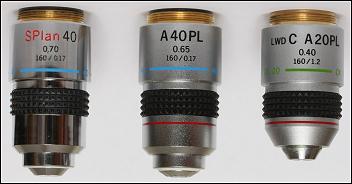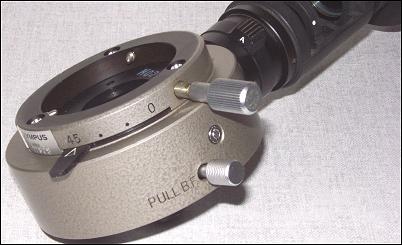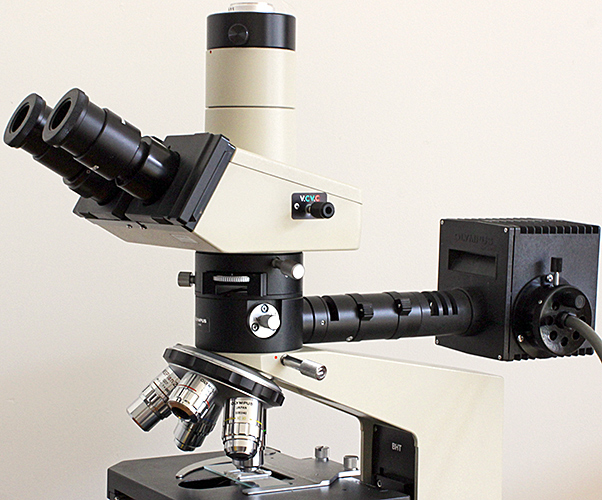Olympus microscopes and photomicrographic equipment
Objective designations for BH and BH-2 microscopes
Detailed information about the biological and metallurgical objectives that were designed for Olympus compound microscopes of the BH era (AH, BH, CH, CK, IMT) can be found in the Olympus High Quality Optics catalogue on the downloads page.
The specifications of the biological objectives that were designed for Olympus compound microscopes of the BH-2 era (AH-2, BH-2, CH-2, CK2, CK40, IMT-2) can be found in the Olympus LB Objective Series for Biological Use catalogue on the downloads page.

Objectives for the BH, BH-2 and other Olympus microscopes of this era have the series, for example “SPlan”, in front of the magnification. Objectives for the BX and other more recent Olympus microscopes have the series above the magnification, and cannot be used with older microscopes.
The following tables are intended as a quick reference to the letters that Olympus used on its objectives in the BH and BH-2 era.
Letters before the magnification
| Letters | Tube length | Parfocal length | Thread | Notes |
|---|---|---|---|---|
| (none) | 160 mm | 36.65 mm | RMS | Achromat |
| A | 160 mm | 45 mm | RMS | Achromat, referred to as D or DAch or D Achromat in catalogues |
| Apo | 160 mm | 36.65 mm | RMS | Apochromat |
| C | 160 mm | 36.65 mm | RMS | Achromat, correction for viewing up through a culture vessel or slide, normally used on inverted microscopes |
| CPL | 160 mm | 36.65 mm | RMS | Achromat, phase contrast (positive low), correction for viewing up through a culture vessel or slide, normally used on inverted microscopes |
| DApo | 160 mm | 45 mm | RMS | Apochromat |
| DPlan | 160 mm | 45 mm | RMS | Achromat, flat field up to F.N. 20, referred to as D Plan Achromat in catalogues |
| DPlanApo | 160 mm | 45 mm | RMS | Apochromat, flat field up to F.N. 20 |
| EA | 160 mm | 45 mm | RMS | Achromat, education or economy series, referred to as EDAch or ED Achromat in catalogues |
| FL | 160 mm | 36.65 mm | RMS | Achromat with fluorite elements |
| LWDC | 160 mm | 36.65 mm | RMS | Achromat, long working distance, correction for viewing up through a culture vessel or slide, normally used on inverted microscopes |
| LWDCA | 160 mm | 45 mm | RMS | Achromat, long working distance, correction for viewing up through a culture vessel or slide, normally used on inverted microscopes |
| LWDCDPlan | 160 mm | 45 mm | RMS | Achromat, flat field, long working distance, correction collar (or correction for viewing up through a culture vessel or slide), normally used on inverted microscopes |
| LWDCPlan | 160 mm | 36.65 mm | RMS | Achromat, flat field, long working distance, correction for viewing up through a culture vessel or slide, normally used on inverted microscopes |
| LWDMPlan | 210 mm | “long mount” | RMS | Metallurgical achromat, flat field, long working distance |
| LWDMSPlan | ∞ f=180 | 45 mm | RMS | Metallurgical achromat, superwide flat field, long working distance |
| LWDMSPlanApo | ∞ f=180 | 45 mm | RMS | Metallurgical apochromat, superwide flat field, long working distance |
| LWDNeoSPlanApo | ∞ f=180 | 45 mm | 26 mm | Metallurgical apochromat, brightfield/darkfield, superwide flat field, long working distance |
| M | 210 mm | 36.65 mm or “long mount” | RMS | Metallurgical achromat (Older versions for the MF are 200 mm tube length and 36.65 mm parfocal, BH versions are 210 mm tube length and were made in 36.65 mm and “long mount” versions) |
| MA | ∞ f=180 | 45 mm | RMS | Metallurgical achromat |
| MDPlan | ∞ f=180 | 45 mm | RMS | Metallurgical achromat, flat field up to F.N. 20 |
| MNH | 210 mm | ? 36.65 mm or “long mount” | RMS | Metallurgical achromat, phase contrast (negative high) |
| MNM | 210 mm | ? 36.65 mm or “long mount” | RMS | Metallurgical achromat, phase contrast (negative medium) |
| MPL | 210 mm | ? 36.65 mm or “long mount” | RMS | Metallurgical achromat, phase contrast (positive low) |
| MPlan | 210 mm | 36.65 mm or “long mount” | RMS | Metallurgical achromat, flat field, made in 36.65 mm and “long mount” versions |
| MPlan N | 210 mm | “long mount” | RMS | Metallurgical achromat, flat field, strain free for interference contrast |
| MPLL | 210 mm | ? 36.65 mm or “long mount” | RMS | Metallurgical achromat, phase contrast (positive low low) |
| MPO | 200 mm | 36.65 mm | RMS | Metallurgical achromat, strain-free for polarising applications |
| MSPlan | ∞ f=180 | 45 mm | RMS | Metallurgical achromat, superwide flat field up to F.N. 26.5 |
| MSPlanApo | ∞ f=180 | 45 mm | RMS | Metallurgical apochromat, superwide flat field up to F.N. 26.5 |
| MUVFL | ∞ f=180 | 45 mm | 26 mm | Metallurgical achromat with fluorite elements, fluorescence-free, for fluorescence applications |
| NCDPlanFL | 160 mm | 45 mm | RMS | Achromat with fluorite elements, flat field up to F.N. 20, no coverslip |
| NCSPlan | 160 mm | 45 mm | RMS | Achromat, superwide flat field up to F.N. 26.5, no coverslip |
| NCSPlanApo | 160 mm | 45 mm | RMS | Apochromat, superwide flat field up to F.N. 26.5, no coverslip |
| NCUVFL | 160 mm | 45 mm | RMS | Achromat with fluorite elements, fluorescence-free, for fluorescence applications, no coverslip |
| NDA | 160 mm | 45 mm | RMS | Achromat, newer version of the A series |
| NEA | 160 mm | 45 mm | RMS | Achromat, newer version of the EA education or economy series |
| Neo | 210 mm | “long mount” | 25 mm | Metallurgical achromat, brightfield/darkfield |
| NeoDPlan | ∞ f=180 | 45 mm | 26 mm | Metallurgical achromat, brightfield/darkfield, flat field up to F.N. 20 |
| NeoPlan | 210 mm | “long mount” | 25 mm | Metallurgical achromat, brightfield/darkfield, flat field |
| NeoSPlan | ∞ f=180 | 45 mm | 26 mm | Metallurgical achromat, brightfield/darkfield, superwide flat field up to F.N. 26.5 |
| NH | 160 mm | 36.65 mm | RMS | Achromat, phase contrast (negative high) |
| NM | 160 mm | 36.65 mm | RMS | Achromat, phase contrast (negative medium) |
| PL | 160 mm | 36.65 mm | RMS | Achromat, phase contrast (positive low) |
| Plan | 160 mm | 36.65 mm | RMS | Achromat, flat field |
| PlanApo | 160 mm | 36.65 mm | RMS | Apochromat, flat field |
| PlanPL | 160 mm | 36.65 mm | RMS | Achromat, phase contrast (positive low), flat field |
| PLL | 160 mm | 36.65 mm | RMS | Achromat, phase contrast (positive low low) |
| PO | 160 mm | 36.65 mm | RMS | Achromat, strain-free for polarising applications, for BH and Vanox microscopes |
| PS | 160 mm | 36.65 mm | RMS | Achromat, strain-free for polarising applications, for POS microscope |
| SPlan | 160 mm | 45 mm | RMS | Achromat, superwide flat field up to F.N. 26.5, strain-free for polarising applications and Nomarski DIC |
| SPlanApo | 160 mm | 45 mm | RMS | Apochromat, superwide flat field up to F.N. 26.5 |
| SPlanFL | 160 mm | 45 mm | RMS | Achromat with fluorite elements, superwide flat field up to F.N. 26.5 |
| ULWDCDPlan | 160 mm | 45 mm | RMS | Achromat, flat field, ultra long working distance, correction collar, normally used on inverted microscopes |
| ULWDMIRPlan | ∞ f=180 | 45 mm | RMS | Metallurgical achromat for infra-red applications, flat field, ultra long working distance |
| ULWDMSPlan | ∞ f=180 | 45 mm | RMS | Metallurgical achromat, superwide flat field, ultra long working distance |
| ULWDNeoSPlan | ∞ f=180 | 45 mm | 26 mm | Metallurgical achromat, brightfield/darkfield, superwide flat field, ultra long working distance |
| UVFL | 160 mm | 45 mm | RMS | Achromat with fluorite elements, fluorescence-free, for fluorescence applications |
| WIMSPlanApo | ∞ f=180 | 45 mm | RMS | Metallurgical apochromat, superwide flat field, for water immersion |
| WPlan | 160 mm | 45 mm | RMS | Achromat, flat field, for water immersion |
| WPlanApo | 160 mm | 45 mm | RMS | Apochromat, flat field, for water immersion |
| WPlanFL | 160 mm | 45 mm | RMS | Achromat with fluorite elements, flat field, for water immersion |
The “short mount” (36.65 mm parfocal) and the “long mount” (approximately 42.5 mm parfocal) objectives were intended for microscopes of the BH era (AH, BH, CH, CK, IMT) and earlier models. For photomicrography, they should be used with the FK photo eyepieces. The eyepieces for viewing do not include an “L” in their designation, for example Bi WF10×.
The 45 mm parfocal long-barrel (LB) objectives were intended for microscopes of the BH-2 era (AH-2, BH-2, CH-2, CK2, CK40, IMT-2). For photomicrography, they should be used with the NFK photo eyepieces. The eyepieces for viewing include an “L” (indicating long barrel) in their designation, for example SWHK 10×L, WHK 10×/20 L, WHK 15×L or CWHK 10×/18L.
Letters after the magnification
| Letters | Notes |
|---|---|
| FPL | Positive Low phase contrast, for use with the combined 10/20/40 annulus on CK30 and CK40 inverted microscopes |
| IC | Strain free, for Nomarski Interference Contrast |
| N | Strain free, for interference contrast. |
| NH | Negative High phase contrast (subject lighter than background, for specimens of relatively low contrast) |
| NIC | Strain free, for Nomarski Interference Contrast |
| NM | Negative Medium phase contrast (subject lighter than background, for specimens of average contrast) |
| PL | Positive Low phase contrast (subject darker than background, for specimens of relatively high contrast) |
| PLL | Positive Low Low phase contrast (subject darker than background, for specimens of high contrast) |
| PO | Strain-free, for polarising applications |
| RP | Relief Phase contrast, for use with special condenser and slider on inverted microscopes |
| UV | Fluorescence-free, for fluorescence applications |
| UVPL | Fluorescence-free, for fluorescence applications, and positive low phase contrast |
Characters after the tube length
On the 36.65 mm parfocal and “long mount” lenses, these numbers appear below the numerical aperture.
| Characters | Notes |
|---|---|
| /– | Can be used with or without a coverslip |
| /0 | Corrected for use without a coverslip |
| /0–2 | Adjustable correction for viewing up through slides or culture vessels of thicknesses up to 2 mm, normally used on inverted microscopes |
| /0.11–0.23 | Adjustable correction for coverslips of thicknesses from 0.11 to 0.23 mm |
| /0.14–0.20 | Adjustable correction for coverslips of thicknesses from 0.14 to 0.20 mm |
| /0.17 | Corrected for use with a 0.17 mm coverslip; the most common correction |
| 0.4–1.0 | Adjustable correction for viewing up through slides or culture vessels of thicknesses from 0.4 to 1.0 mm, normally used on inverted microscopes |
| /1 | Corrected for viewing up through a 1 mm slide or culture vessel, normally used on inverted microscopes |
| /1.2 | Corrected for viewing up through a 1.2 mm slide or culture vessel, normally used on inverted microscopes |
| 1.20 | Corrected for viewing up through a 1.20 mm slide or culture vessel, normally used on inverted microscopes |
Other letters
| Letters | Notes |
|---|---|
| dry | Immersion oil must not be used; appears only on high magnification lenses |
| HI | Homogeneous immersion; immersion oil must be used between the objective and the slide, and should be used between the condenser and the slide |
| LWD | Long working distance |
| NOCOVER | Corrected for use without a coverslip |
| oil | Immersion oil must be used between the objective and the slide, and should be used between the condenser and the slide |
| SI | Silicone immersion; silicone oil must be used between the objective and the slide |
| Sil | Silicone immersion; silicone oil must be used between the objective and the slide |
| Water | Water immersion; water must be used between the objective and the slide |
| WI | Water immersion; water must be used between the objective and the slide |
Metallurgical objectives and vertical illuminators
The metallurgical objectives are intended to be used with reflected light from a vertical illuminator that is fitted between the stand and the head. They can also be used with transmitted light via the substage condenser, but a vertical illuminator is still needed to provide the proper 210 mm tube length or a tube lens.
For the M, MPlan, Neo and NeoPlan 36.65 mm parfocal objectives for the BH microscope, the illuminators are part grey and part black. The BH-MA is for the brightfield M and MPlan objectives, and the BH-RLA is for the brightfield/darkfield Neo and NeoPlan objectives; the BH-RLA can be distinguished by a knob labelled “PULL BF”. The objectives are corrected for the longer tube length (210 mm) caused by the vertical illuminator. A few of these illuminators are all black, but they can be distinguished from the BH2 versions by the absence of the “∞ f=180” label.

BH-RLA brightfield/darkfield vertical illuminator (for BH microscope with BH-NRE nosepiece and Neo or NeoPlan 36.65 mm metallurgical objectives)
For the MA, MDPlan, MSPlan, NeoDPlan and NeoSPlan 45 mm parfocal objectives for the BH-2 microscope, there were 2 series of illuminators. The first series is all black, the BH2-MA Brightfield Vertical Illuminator for the MA, MDPlan and MSPlan objectives, and the BH2-RLA Brightfield/Darkfield Vertical Illuminator for the NeoDPlan and NeoSPlan objectives; the BH2-RLA can be distinguished by a knob labelled “PULL BF”.

Olympus BHT with BH2-MA vertical illuminator and infinity-corrected MSPlan objectives
Both black illuminators were replaced by the cream BH2-UMA Universal Vertical Illuminator, which can be fitted with the BH2-UBF brightfield cube and/or the BH2-UDF darkfield cube; the active cube can be selected by a sliding knob on the front. Both series of BH2 vertical illuminators include the tube lens (f = 180 mm) that is essential for these infinity-corrected objectives, and are labelled “∞ f=180”.
Send comments or questions to Alan Wood
![]()
Created 10th December 2010 — Updated 30th July 2017
Copyright © 2010–2017 Alan Wood